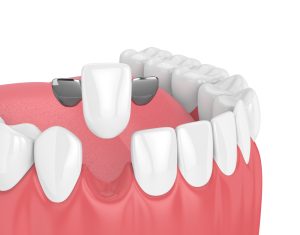Restoring Your Smile with Precision and Elegance
At Polasek Digital Dentistry & Schaefer Dental Group in Howell, MI, we understand the importance of preserving your natural tooth structure while providing effective solutions for missing teeth. Maryland dental bridges, also known as resin-bonded bridges, offer a minimally invasive approach to tooth replacement, combining function and aesthetics seamlessly.
Howell, MI, dentist, Dr. Kyle Polasek and his team are dedicated to helping you make informed decisions about your oral health. If you have any questions or would like to schedule a consultation, please don’t hesitate to contact our Southeast Michigan dental practice at (517) 546-8983.
What Are Maryland Dental Bridges?
Maryland dental bridges are a type of dental prosthesis designed to replace one or more missing teeth without the need for extensive tooth preparation. Unlike traditional dental bridges that require the adjacent teeth to be crowned, Maryland bridges utilize a metal or porcelain framework bonded to the back of the neighboring teeth, providing support for the artificial tooth or teeth.
The Benefits of Maryland Dental Bridges
Choosing a Maryland dental bridge offers several advantages, including:
- Tooth Conservation: Maryland bridges require minimal alteration to the adjacent healthy teeth, preserving their natural structure and reducing the risk of long-term damage.
- Non-Invasive Procedure: The process of getting a Maryland dental bridge is generally quicker and less invasive compared to other restorative dentistry options, involving minimal tooth preparation and a shorter recovery time.
- Aesthetic Enhancement: These bridges are customized to match the color, shape, and appearance of your natural teeth, providing a seamless and natural-looking solution for improving your smile.
- Functional Restoration: By replacing missing teeth, Maryland bridges help restore your ability to chew and speak properly, ensuring optimal oral function.
- Cost-Effective Solution: Maryland bridges are often more cost-effective than traditional bridges, as they require less dental work and materials.
Comparing Maryland and Traditional Dental Bridges
While both Maryland and traditional dental bridges serve the purpose of replacing missing teeth, there are some key differences:
- Tooth Preparation: Traditional bridges require significant enamel removal from the adjacent teeth to accommodate dental crowns, whereas Maryland bridges involve minimal tooth preparation.
- Strength and Stability: Traditional bridges, with their crowns, provide excellent strength and stability. Maryland bridges, on the other hand, offer sufficient strength and stability for replacing front teeth or areas with less biting force.
- Aesthetics: Both types of bridges can be customized for a natural appearance. However, traditional bridges may offer slightly better aesthetics due to the use of dental crowns.
The Maryland Dental Bridge Process at Polasek Digital Dentistry & Schaefer Dental Group
- Initial Consultation: Your dental bridge journey begins with a comprehensive evaluation of your oral
health. Dr. Polasek will determine if a Maryland dental bridge is the most suitable option for your individual case.
- Preparation: If a Maryland bridge is recommended, the adjacent teeth will undergo minimal enamel removal to create space for the bridge to be bonded in place. Impressions of your teeth will be taken and sent to a dental laboratory for the fabrication of your custom bridge.
- Temporary Bridge: While your permanent bridge is being crafted, a temporary solution may be provided to protect your exposed teeth and gums.
- Bridge Fitting: Once your custom bridge is ready, you’ll return to our Howell office for the fitting. Dr. Polasek will ensure a comfortable and precise fit, making any necessary adjustments.
- Bonding: The Maryland bridge is then securely bonded to the adjacent teeth using dental cement, ensuring a strong and stable hold.
- Final Adjustments: After the bonding process, Dr. Polasek will carefully check your bite and make any necessary adjustments to ensure proper alignment and function.
Frequently Asked Questions
While Maryland dental bridges are considered permanent in the sense that they are not removable by the patient, they may not last a lifetime. With proper care, including excellent oral hygiene and regular dental check-ups, a Maryland bridge can provide a long-lasting solution for many years.
The process of getting a Maryland dental bridge is typically not painful. Local anesthesia is used during the preparation phase to ensure your comfort. After the procedure, you may experience mild sensitivity or discomfort as your mouth adjusts to the new bridge, but this is usually temporary.
Maryland dental bridges are a suitable option for some cases, but not all. They work best when the adjacent teeth are strong and healthy, as they rely on these surrounding teeth for support. Your dentist will evaluate your oral health, the condition of neighboring teeth, and other factors to determine if a Maryland bridge is the right choice for you.





 health. Dr. Polasek will determine if a Maryland dental bridge is the most suitable option for your individual case.
health. Dr. Polasek will determine if a Maryland dental bridge is the most suitable option for your individual case.